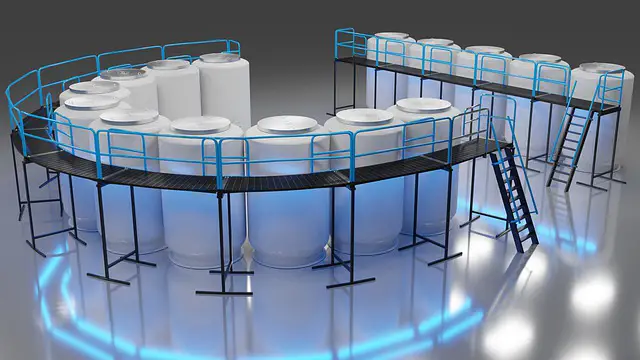Cryogenics deals with the study of low-temperature effects on materials, cryonics pertains to the preservation of a human body or head at subzero temperatures in an attempt to potentially revive them in the future. Cryogenic research has made great strides in helping humanity improve our knowledge and understanding of medicine, chemistry, physics and more.
What is cryogenics?
(Image by harmonynotapathy from Pixabay )

Cryogenics is the branch of science that deals with the study of very low temperatures and their effects on materials and biological systems. It involves the use of extremely low temperatures, typically below -150°C (-238°F), to preserve and store biological samples, such as sperm, eggs, embryos, and tissue, for future use. The process of cryopreservation involves cooling a sample to a very low temperature, typically using liquid nitrogen, which slows down or stops all biological activity. Cryogenics is also used in the production of superconducting materials, which can conduct electricity with zero resistance at extremely low temperatures. It has applications in various fields, including medicine, biology, materials science, and physics.
What is cryonics?
Cryonics is the practice of freezing a human body with the hope of someday reviving it. The idea is that by freezing the body, the person can be preserved until medical science advances to a point where they can be revived and cured of whatever ailment caused their death.
The difference between cryogenics and cryonics
There are a few key differences between cryogenics and cryonics. For starters, cryogenics is the science of low temperatures and how to achieve them, while cryonics is the practice of using those low temperatures to preserve humans and animals. Cryonicists believe that by cooling down the body to subzero temperatures, they can halt the aging process and essentially keep a person alive indefinitely.
Cryogenics is based on the fact that many chemical reaction rates decrease at lower temperatures. So by cooling down the body, cryonicists hope to slow down all the biochemical processes that lead to death. There is some evidence that this may be possible: for example, frozen embryos have been successfully thawed and implanted, leading to healthy births. But it’s unclear whether this can be done with an adult human body.
The second major difference between these two fields is that cryonics requires freezing not just the body, but also the brain. This is because when the heart stops pumping blood, brain cells start dying within minutes. So in order for a person to be revived from cryonic suspension, their brain must be preserved intact. This poses a challenge, as current freezing techniques often damage brain cells.
So far, there are no known cases of anyone being successfully revived from cryonic suspension. But some scientists believe it may someday be possible, given advances in technology. Whether or not you believe in cryonics, it’s an intriguing field worth learning more about!
What is the difference between cryonics and cryopreservation?
Cryonics and cryopreservation are related concepts, but they are not the same thing.
Cryopreservation is a process of preserving biological material at very low temperatures, typically below -150°C (-238°F), to prevent degradation and damage. This technique is used to preserve various biological materials such as sperm, eggs, embryos, tissue, and organs for long-term storage and future use.
Cryonics, on the other hand, is a controversial and speculative practice that involves freezing a human body or brain at very low temperatures, typically below -196°C (-321°F), in the hopes of reviving it in the future using advanced medical technologies. Cryonics is a form of cryopreservation, but it is focused specifically on the preservation of human remains with the goal of eventual revival, rather than preservation for immediate use.
In summary, cryopreservation is a widely accepted scientific technique used to preserve biological materials for future use, while cryonics is a speculative practice that aims to revive human remains in the future, and is not currently considered a viable medical option by the scientific community.
Can a human survive cryogenic freezing?
Yes, a human can survive cryogenic freezing. The process of cryogenic freezing is used to preserve tissues and organs at very low temperatures. This allows for the long-term storage of these tissues and organs, which can be used for transplantation or research purposes. The process of cryogenic freezing is also used to preserve cells, sperm, and eggs for future use.
Do you age in cryogenic sleep?
There is a lot of debate surrounding whether or not you age while in cryogenic sleep. The jury is still out on this one, as there is not enough scientific evidence to say for sure one way or the other. However, some experts believe that you do age while in cryogenic sleep, just at a much slower rate than if you were not in cryogenic sleep. This is due to the fact that your body is in a state of extreme cold and slowed down metabolism. So, while you may not look any older when you wake up from cryogenic sleep, you may be slightly older on the inside.
How long can cryonics last?
Cryonics is the practice of storing human remains at extremely cold temperatures in the hope that resuscitation and revival may be possible in the future. Cryogenics, on the other hand, is the study of how materials respond to extremely cold temperatures.
There is no definitive answer to how long cryonics can last, as it is an experimental procedure with no guarantee of success. However, some estimates suggest that cryopreserved tissue could potentially remain viable for millions of years. Of course, this is assuming that future technology is able to successfully revive and resuscitate cryopreserved patients.
What is the purpose of cryogenics?
The purpose of cryogenics is to study the effects of very low temperatures on materials and biological systems, as well as to use these low temperatures to preserve and store biological materials for future use. The field has a wide range of applications, including:
Cryopreservation: Cryogenic techniques are used to preserve biological materials such as sperm, eggs, embryos, tissue, and organs for long-term storage and future use.
Medicine: Cryogenics has various medical applications, including the use of cryogenic temperatures to treat cancerous tumors, preserve blood and bone marrow, and study the effects of low temperatures on the human body.
Materials science: Cryogenics is used to produce and study superconducting materials, which can conduct electricity with zero resistance at extremely low temperatures. This has applications in the development of high-speed trains, medical equipment, and computer chips.
Space exploration: Cryogenic fuels are used in rockets and other spacecraft as they provide a high energy density with low weight, allowing for longer space missions.
The purpose of cryogenics is to better understand the effects of low temperatures on materials and living systems, and to develop practical applications that can improve our lives and advance science and technology.
Who is the oldest cryogenically frozen person?
The oldest cryogenically frozen person is Dr. James Bedford, a psychology professor at the University of California who died on January 12, 1967, from kidney cancer. He was placed in cryonic suspension in the same year at the Alcor Life Extension Foundation in Arizona, USA. Dr. Bedford’s body has been in continuous cryonic suspension for over 54 years. There are other cryonically preserved individuals who have been frozen for a similar length of time, but Dr. Bedford is considered the first person to have been cryonically preserved.
How is cryogenics legal?
Cryogenics is the study of how to cool materials to extremely low temperatures. It is legal because it is not considered a medical procedure. Cryonics, on the other hand, is considered a medical procedure because it involves the use of medical techniques and equipment to cool and preserve the body of a person who has died.
How many people are currently cryogenically frozen?
The exact number of people who are currently cryogenically frozen is not publicly known, as many cryonics organizations keep their membership lists private. However, it is estimated that several hundred people have been cryogenically preserved worldwide, with most being located in the United States. The Cryonics Institute, a leading cryonics organization based in Michigan, reported in 2021 that they had 2,100 living members and 198 people in cryonic suspension. Another major organization, Alcor Life Extension Foundation in Arizona, reported in 2021 that they had over 180 people in cryonic suspension. Other organizations, such as KrioRus in Russia and Oregon Cryonics in the United States, also have cryonically preserved individuals. It’s important to note that cryonics is a controversial and unproven practice, and the long-term viability of cryonically preserved individuals is currently unknown.
Featured Image By – Photo by Scott Rodgerson on Unsplash








